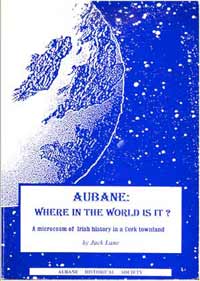



Twenty-Four Aubane Historical Society Pamphlets available as PDF files:—Free Downloads
Also available FREE New Pamphlet
|
Another PDF Download
What Was The Somme? - Leaflet distributed 12th & 13th July, 2008
What's
New All Over
On Athol Books WebSite (including Aubane, Church & State etc?
Just click on the titles to download
This Society was founded by a number of local people in Aubane in 1985. It aims to contribute to the growing body of local history publications being produced across the country.
It concentrates on the local Aubane and Millstreet area as well as North Cork generally. It seeks to make available original and first hand accounts of various aspects of our history.
We rely on our own resources but we appreciate any support and are particularly grateful to Integrated Rural Development (IRD) Duhallow Ltd. for their assistance with a number of our publications.
We have produced over 30 publications so far in various formats. Those in print are available via this site.
If you have any comments or views on our work we would be pleased to hear from you.
Jack Lane
Most Recent Update:—Monday, July 27, 2020
Troubled History
Ten years of controversy in Irish history
A 10th anniversary critique of Peter Hart's The IRA and its Enemies
Niall Meehan (Head, Journalism & Media Faculty, Griffith
College Dublin, Ireland) & Brian P Murphy OSB (Member of the Benedictine
Community, Glenstal, Limerick, Ireland) With an Introduction by Ruan O'Donnell
(Head, History Department, The University of Limerick, Ireland)
Now Availabe As A Free Download
Niall Meehan examines Peter Hart's arguments in the context of political
pressures in Irish society affecting the writing of Irish history. In particular,
he looks at the effect of violence in Northern Ireland post 1968. The threat
of violence was used to inhibit intellectual inquiry in Southern Ireland.
State censorship, perfected by Dr Conor Cruise O'Brien while a minister
from 1973-1977, was accompanied by attacks on print media, on dissenting
academics and on civil liberties. This, argues Meehan, helped to stabilise
a new orthodoxy that privileged reframing the earlier Irish Troubles of
1916-21 as a religious or ethnic conflict. Within this new framework Peter
Hart's research emerged and was uncritically applauded in 1998.
Meehan publishes for the first time an affidavit from the son of the last
surviving participant in the Kilmichael ambush of November 28, 1920. He
also publishes a newspaper report of the death of this ambush veteran. Peter
Hart claimed to have interviewed an ambush participant anonymously one day
later. In the affidavit it is claimed that Hart could not have interviewed
the last surviving participant. The sole surviving IRA veteran suffered
a stroke affecting his mobility and speech over a year prior to Hart's claimed
anonymous interviews with two such veterans. Meehan pursues these and also
newly discovered inconsistencies in Hart's account of sectarianism during
the conflict. He attempts an explanation of why these deficiencies are ignored
by mainstream Irish historians.
Brian Murphy examines the way in which Peter Hart's research on Cork during Ireland's War of Independence has been used to encourage the view that Catholic-Protestant antagonisms were a significant feature of the conflict. Murphy answers criticism of his research on British Propaganda in 1920 by David Leeson of Laurentian University, Canada. Murphy also examines Leeson's defense of Peter Hart. Murphy indicates the extent of significant Protestant support for Irish Independence. He takes issue with a recent Irish television documentary that pursued the Hart sectarianism thesis in another part of Ireland during the War of Independence.
Ruan O'Donnell, in his introduction, makes the point that 'the highly contentious
nature of the revolutionary period has found an echo in the hostile tenor
present in some of the debates between scholars. Questions of interpretation
are inevitable in such dialogues and important issues have also arisen in
relation to the reliability of certain classes of historical evidence. Something
of the heat of these clashes stems, in all probability, from proximity to
'the Long War'. Connections between 1922 and 1998 are obviously more profound
than the mere repetition of nomenclature and re-articulation of slogans
but contemporary judgments on this issue must, as yet, remain tentative.
It is to be hoped that a fuller and more nuanced grasp of Irish history
will emerge from the new histories of the new Ireland.'
Published June 2008, Price $10/€10/£7
(available in hard copy and in PDF format)
ISBN 978-1-903497–46-3
To secure your copy of this important new Irish historical research: